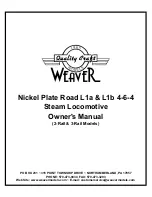
❍ ❍
1. Take a close look at the supplied hinges. The above
photo has this slot highlighted and must be inserted into
place in the proper direction as indicated in the photo.
❍ ❍
2. Test fit the hinges in the hinge slots of the aileron
and the wing. If you have difficulty inserting the hinges,
insert a #11 blade into the slot and carefully move it back
and forth to slightly widen the slot. Test fit the aileron to the
wing with the hinges.
❍ ❍
3. If the hinges don’t remain centered, stick a pin through
the middle of the hinge to hold it in position as shown.
❍ ❍
4. Coat the “arm” portion of the aileron torque rod that
slips inside the aileron and the groove, and the hole in the
aileron where the torque rod fits, with 30-minute epoxy. Tip:
You may want to use a toothpick to get epoxy into the hole
drilled in the aileron for the aileron torque rod “arm.”
❍ ❍
Use a strip of waxed paper between the torque rod and
the wing to keep from gluing the torque rod to the wing. Be
careful to keep the epoxy out of the area where the rod
enters the trailing edge of the wing. Place a small amount of
petroleum jelly in this area. Join the aileron to the wing and
the torque rod with the hinges. Wipe away excess epoxy
with a tissue saturated with alcohol.
❍ ❍
5. Remove the T-pins if you’ve used any. Adjust the
aileron so there is a small gap—just enough to see light
through or to slip a piece of paper through—between the
aileron and the wing.
❍ ❍
6. Apply six drops of thin CA to the top and bottom of
each hinge. Do not use CA accelerator. After the CA has
fully hardened, test the hinges by pulling on the aileron. Go
back and install the other aileron in the same manner.
7








































